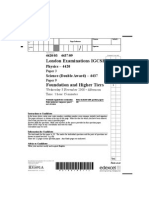Topic Test: Oxfordaqa International A Level Physics
Uploaded by
andhi soesiloTopic Test: Oxfordaqa International A Level Physics
Uploaded by
andhi soesiloName: ________________________
Topic Test: OxfordAQA
International A level Physics Class: ________________________
Exponential Change
Date: ________________________
Time: 56 minutes
Marks: 44 marks
Comments:
Oxford International AQA Examinations Page 1 of 16
The graph below shows how the charge stored by a capacitor varies with time when it is
1 discharged through a fixed resistor.
(a) Determine the time constant, in ms, of the discharge circuit.
time constant ____________________ ms
(3)
(b) Explain why the rate of discharge will be greater if the fixed resistor has a smaller
resistance.
___________________________________________________________________
___________________________________________________________________
___________________________________________________________________
___________________________________________________________________
___________________________________________________________________
(2)
(Total 5 marks)
Oxford International AQA Examinations Page 2 of 16
The figure below shows part of the discharge curve for a capacitor that a manufacturer tested for
2 use in a heart pacemaker.
The capacitor was initially charged to a potential difference (pd) of 1.4 V and then discharged
through a 150 Ω resistor.
(a) Show that the capacitance of the capacitor used is about 80 μF.
___________________________________________________________________
___________________________________________________________________
___________________________________________________________________
___________________________________________________________________
___________________________________________________________________
(3)
(b) Explain why the rate of change of the potential difference decreases as the capacitor
discharges.
___________________________________________________________________
___________________________________________________________________
___________________________________________________________________
___________________________________________________________________
___________________________________________________________________
___________________________________________________________________
(3)
Oxford International AQA Examinations Page 3 of 16
(c) Calculate the percentage of the initial energy stored by the capacitor that is lost by the
capacitor in the first 0.015 s of the discharge.
energy lost ______________________%
(3)
(d) The charge leaving the capacitor in 0.015 s is the charge used by the pacemaker to
provide a single pulse to stimulate the heart.
(i) Calculate the charge delivered to the heart in a single pulse.
charge ______________________C
(1)
(ii) The manufacturer of the pacemaker wants it to operate for a minimum of 5 years
working at a constant pulse rate of 60 per minute.
Calculate the minimum charge capacity of the power supply that the manufacturer
should specify so that it will operate for this time.
Give your answer in amp-hours (Ah).
minimum capacity ______________________Ah
(2)
(Total 12 marks)
Oxford International AQA Examinations Page 4 of 16
A Geiger-Muller tube and counter were used to detect β– particles emitted by a source during a
3
radioactivity experiment. The diagram below shows the corrected count rate detected by the
counter plotted against time since the beginning of the experiment.
(a) Draw on the graph the curve that best fits these data.
Use the graph to determine the half-life of the radioactive source as accurately as you can.
Half-life ____________________
(3)
Oxford International AQA Examinations Page 5 of 16
(b) State why the count rate has to be corrected before it is plotted on the graph.
___________________________________________________________________
___________________________________________________________________
___________________________________________________________________
___________________________________________________________________
(2)
(c) Explain how the graph and your final answer for the half-life would change if the correction
were not applied.
___________________________________________________________________
___________________________________________________________________
___________________________________________________________________
___________________________________________________________________
___________________________________________________________________
(2)
(d) Describe, giving reasons, how you would determine an accurate value for the correction.
___________________________________________________________________
___________________________________________________________________
___________________________________________________________________
___________________________________________________________________
___________________________________________________________________
___________________________________________________________________
___________________________________________________________________
___________________________________________________________________
(3)
(Total 10 marks)
Thallium–208 is a radioactive nuclide with a half-life of 183 s.
4 It decays to a stable nuclide, lead–208
At time t = 0, a pure sample of thallium–208 contains 6.5 × 1020 nuclei.
Oxford International AQA Examinations Page 6 of 16
(a) Define decay constant.
___________________________________________________________________
___________________________________________________________________
(1)
(b) Calculate the number of nuclei of thallium–208 nuclei that decay between t = 0 and t = 400
s.
number of nuclei = ____________________
(3)
(c) Sketch on the axes below a graph of the variation with time of the number of lead–208
nuclei in the sample.
(2)
(Total 6 marks)
Oxford International AQA Examinations Page 7 of 16
The carbon content of living trees includes a small proportion of carbon-14, which is a radioactive
5 isotope. After a tree dies, the proportion of carbon-14 in it decreases due to radioactive decay.
(a) (i) The half-life of carbon-14 is 5740 years.
Calculate the radioactive decay constant in yr–1 of carbon-14.
decay constant ____________________ yr–1
(1)
(ii) A piece of wood taken from an axe handle found on an archaeological site has 0.375
times as many carbon-14 atoms as an equal mass of living wood.
Calculate the age of the axe handle in years.
age ____________________ yr
(3)
(b) Suggest why the method of carbon dating is likely to be unreliable if a sample is:
(i) less than 200 years old,
______________________________________________________________
______________________________________________________________
______________________________________________________________
(ii) more than 60 000 years old.
______________________________________________________________
______________________________________________________________
______________________________________________________________
(2)
(Total 6 marks)
Oxford International AQA Examinations Page 8 of 16
In naturally-occurring carbon, most of the atoms are stable but one atom in 1012 is the radioactive
6
isotope . The decay constant for is 3.8 × 10–12 s–1.
Carbon dioxide molecules each contain one atom of carbon.
What is the activity of the carbon in 0.25 mol of naturally-occurring carbon dioxide?
A 0.57 Bq
B 2.3 Bq
C 5.7 × 1011 Bq
D 2.3 × 1012 Bq
(Total 1 mark)
Radioactive decay is considered to be:
7
A spontaneous because all nuclei of a particular nuclide have different
decay constants.
B random because it is not possible to predict whether a nucleus will
emit an alpha particle, a beta particle or a gamma ray.
C random because it is not possible to predict when a particular
nucleus will decay.
D spontaneous because it happens suddenly when triggered by an
event.
(Total 1 mark)
Oxford International AQA Examinations Page 9 of 16
In the circuit shown the capacitor C charges when switch S is closed.
8
Which line, A to D, in the table gives a correct pair of graphs showing how the charge on the
capacitor and the current in the circuit change with time after S is closed?
charge current
A graph 1 graph 1
B graph 1 graph 2
C graph 2 graph 2
D graph 2 graph 1
(Total 1 mark)
Oxford International AQA Examinations Page 10 of 16
A voltage sensor and a datalogger are used to record the discharge of a 10 mF capacitor in
9 series with a 500 Ω resistor from an initial pd of 6.0 V. The datalogger is capable of recording
1000 readings in 10 s.
After a time equal to the time constant of the discharge circuit, which one of the rows gives the pd
and the number of readings made?
Potential difference / V Number of readings
A 2.2 50
B 3.8 50
C 3.8 500
D 2.2 500
(Total 1 mark)
A capacitor discharges through a 22 kΩ resistor. It takes 0.75 s for the potential difference across
10 the capacitor to fall from 8.0 V to 4.0 V.
What is the capacitance of the capacitor?
A 34 μF
B 49 μF
C 68 μF
D 98 μF
(Total 1 mark)
Oxford International AQA Examinations Page 11 of 16
Mark schemes
(a) (Q = Q 0e−t /RC gives )1.0 = 4.0e−300 / RC
1
from which
[Alternative answer:
time constant is time for charge to decrease to Q0 /e [or 0.37 Q0 ]
4.0/e = 1.47
reading from graph gives time constant = 216 ± 10 (ms)
In alternative scheme, 4.0/e = 1.47 subsumes 1st mark. Also,
accept T½ = 0.693 RC (or = ln 2 RC) for 1st mark.
3
(b) current is larger (for given V)(because resistance is lower)
[or correct application of I = V / R]
current is rate of flow of charge
[or correct application of I =Δ Q / Δt]
larger rate of flow of charge (implies greater rate of discharge)
[or causes larger rate of transfer of electrons from one plate back to the other]
[Alternative answer:
time constant (or RC) is decreased (when R is decreased)
explanation using Q = Q0e−t / RC or time constant explained ]
Use either first or alternative scheme; do not mix and match.
Time constant = RC is insufficient for time constant explained.
max 2
[5]
(a) time to halve = 0.008 s or two coordinates correct
2
C1
C = T1/2/(0.69 × 150) or eg 0.4 = 1.4 e–0.015/150C
A1
77 μF (consistent with numerical answer)
A1
3
Oxford International AQA Examinations Page 12 of 16
(b) max 3 from
as capacitor discharges:
pd decreases
B1
current through resistor decreases (since I V)
B1
rate at which charge leaves the capacitor decreases (since I = ∆Q/∆t)
B1
rate of change of charge is proportional to rate of change of pd
(since V Q)
B1
condone quicker discharge when pd is larger
B1
3
(c) energy stored ∝ V 2 or use of ½ CV 2
or initial energy = 78.4 (or 75.5) μJ
or final energy using V = 0.38–0.4 0 V
(answer in range 5.6 – 6.4 μJ)
C1
fraction remaining = (0.4/1.4)2 or 0.072 – 0.081
or energy lost = 72 μJ
C1
91.8 to 92.8% lost
A1
3
(d) (i) charge = 77 μC to 82 μC
B1
1
Oxford International AQA Examinations Page 13 of 16
(ii) charge required = 77 × 10–6 × 5 × 3.15 × 107 (= 12128 C)
or 1A–h =3600 C
C1
3.36(3.4) Ah
A1
2
[12]
(a) Draw curve in on graph (at least one point missed)
3 B1
Clear use of graph to determine half-life
B1
[repeat and average required]
Answer in range 650 ± 50 s [600–700]
B1
(b) Mention of background radiation
B1
because this increases the count rate
B1
(c) Curve displaced upwards
B1
leading to half-life that is too long
B1
(d) Take count with source absent
B1
Over long time (5+ min) or Average several times (3
or more) and…
B1
Because background is small or subtract correction
Or correction is negative
B1
[10]
(a) Probability of decay per unit time ✓
4
Condone ratio of activity to number of nuclei present
1
Oxford International AQA Examinations Page 14 of 16
(b) Uses λ = or 3.79 × 10−3 seen
Uses N = N0e−λt or 1.4(3) × 1020 seen
5.1 or 5.07 × 1020
3
(c) Correct general shape starting at origin and appearing to become asymptotic ✓
Points to look for: (0, 0) (183, 3.25) (366, 4.88) (400,
5.07) (549, 5.69)
1 correct data point and smooth curve that is asymptotic at 6.5 ✓
2
[6]
5 (a) (i) λ ( = ln 2 / T1 / 2 = 0.693 / 5740 ) = 1.2 × 10−4 (yr−1) ✓
(1.21 × 10−4 yr−1)
only allow 3.83 × 10−12 s−1 if the unit has been changed
working is not necessary for mark
1
(ii) (use of Nt = No e– λt and activity is proportional to N
At = Ao e– λt )
0.375 = exp - (1.21 × 10−4 × t) ✓
t= ✓
t = 8100 or 8200(yr) ✓
1st mark substitution, allow EC from (i)
2nd mark rearranging, allow EC from (i)
Allow t / T1 / 2 = 2 n approach
3rd mark no EC (so it is not necessary to evaluate a CE)
so max 2 for a CE
full marks can be given for final answer alone. A minus in the final
answer will lose the last mark
3
Oxford International AQA Examinations Page 15 of 16
(b) (i) (it is difficult to measure accurately)
the small drop / change in activity / count-rate
the small change / drop in the ratio of C-14 to C-12 ✓
the activity would be very small / comparable to the background
or the ratio of C-14 to C-12 is too small
or there are too few C-14 atoms
or there is very little decay
or the level of C-14 (in the biosphere) is uncertain (this long ago) ✓
1st mark needs some reference to a change in count-rate or activity
for the mark
be lenient in 2nd mark
in reading a script assume C-14 is the subject. Eg ‘there is little
activity to work with’ scores mark. Also allow any reasonable
suggestion. Eg carbon may have been removed by bonding to
surrounding material
Don't allow, ‘ All the carbon has decayed’
2
[6]
A
6
[1]
C
7
[1]
D
8
[1]
D
9
[1]
B
10
[1]
Oxford International AQA Examinations Page 16 of 16
You might also like
- Harry B. Joseph - Book of Wisdom. 1-Revival of Wisdom92% (71)Harry B. Joseph - Book of Wisdom. 1-Revival of Wisdom123 pages
- COSMIC CONSCIOUSNESS OF HUMANITY - PROBLEMS OF NEW COSMOGONY (V.P.Kaznacheev,. Л. V. Trofimov.)94% (215)COSMIC CONSCIOUSNESS OF HUMANITY - PROBLEMS OF NEW COSMOGONY (V.P.Kaznacheev,. Л. V. Trofimov.)212 pages
- Student Exploration: Fan Cart Physics (Answer Key)46% (24)Student Exploration: Fan Cart Physics (Answer Key)4 pages
- The Road From Orion (The Isis Thesis Book 1)100% (20)The Road From Orion (The Isis Thesis Book 1)178 pages
- The Vodou Quantum Leap Alternative, Realities Power and Mystic - Reginald Crosley96% (46)The Vodou Quantum Leap Alternative, Realities Power and Mystic - Reginald Crosley386 pages
- The Manual of Free Energy Devices and Systems100% (2)The Manual of Free Energy Devices and Systems128 pages
- Topic Test Oxfordaqa Int As Level Physics ElectricityNo ratings yetTopic Test Oxfordaqa Int As Level Physics Electricity17 pages
- U.S. Silently Tortures Americans With Cell Tower Electromagnetic Neuroweapon100% (1)U.S. Silently Tortures Americans With Cell Tower Electromagnetic Neuroweapon7 pages
- Topic Test Oxfordaqa International Gcse Physics 9203 Forces and Their Effects100% (1)Topic Test Oxfordaqa International Gcse Physics 9203 Forces and Their Effects12 pages
- A Level Physics Unit 3 Mark Scheme Jan19No ratings yetA Level Physics Unit 3 Mark Scheme Jan1911 pages
- Topic Test Oxfordaqa Int A Level Physics Electric Fields and CapacitanceNo ratings yetTopic Test Oxfordaqa Int A Level Physics Electric Fields and Capacitance15 pages
- Topic Test: Oxfordaqa International A Level PhysicsNo ratings yetTopic Test: Oxfordaqa International A Level Physics16 pages
- Topic Test: Oxfordaqa International As Level Physics100% (1)Topic Test: Oxfordaqa International As Level Physics15 pages
- Topic Test Oxfordaqa Int A Level Physics Nuclear Energy100% (1)Topic Test Oxfordaqa Int A Level Physics Nuclear Energy14 pages
- International AS Level Physics Example Responses PH02 Unit2No ratings yetInternational AS Level Physics Example Responses PH02 Unit242 pages
- 9630 PH01 International As Physics Specimen Paper 2016 v2No ratings yet9630 PH01 International As Physics Specimen Paper 2016 v224 pages
- Topic Test Oxfordaqa Int As Level Physics Particles Radiation and RadioactivityNo ratings yetTopic Test Oxfordaqa Int As Level Physics Particles Radiation and Radioactivity9 pages
- Topic Test Oxfordaqa Int A Level Physics Magnetic FieldsNo ratings yetTopic Test Oxfordaqa Int A Level Physics Magnetic Fields12 pages
- Topic Test: Oxfordaqa International A Level PhysicsNo ratings yetTopic Test: Oxfordaqa International A Level Physics15 pages
- Topic Test Oxfordaqa Int A Level Physics Circular and Periodic MotionNo ratings yetTopic Test Oxfordaqa Int A Level Physics Circular and Periodic Motion14 pages
- Examiner Tips For o Level Physics 5054 FinalNo ratings yetExaminer Tips For o Level Physics 5054 Final10 pages
- International A Level Physics Example Responses PH04 Unit4No ratings yetInternational A Level Physics Example Responses PH04 Unit453 pages
- Edexcel IAL Physics Unit 4 October 2021 Question Paper50% (4)Edexcel IAL Physics Unit 4 October 2021 Question Paper28 pages
- A Level Physics Unit 3 Mark Scheme Jan20No ratings yetA Level Physics Unit 3 Mark Scheme Jan209 pages
- Unit 5 - Physics From Creation To Collapse: Thermal EnergyNo ratings yetUnit 5 - Physics From Creation To Collapse: Thermal Energy12 pages
- October 2017 (IAL) QP - Unit 1 Edexcel Physics A-LevelNo ratings yetOctober 2017 (IAL) QP - Unit 1 Edexcel Physics A-Level28 pages
- Topic Test Oxfordaqa International Gcse Physics 9203 Generating and Distributing Electricity and Household Use100% (2)Topic Test Oxfordaqa International Gcse Physics 9203 Generating and Distributing Electricity and Household Use12 pages
- Edexcel IAL Physics Unit 5 October 2021 Markscheme (MS)100% (2)Edexcel IAL Physics Unit 5 October 2021 Markscheme (MS)19 pages
- 9280 S TN InternationalEnglishasaSecondLanguage G 29Mar24to3May24No ratings yet9280 S TN InternationalEnglishasaSecondLanguage G 29Mar24to3May2416 pages
- AS Mathematics - Practice Paper - Differentiation (Part 1) MSNo ratings yetAS Mathematics - Practice Paper - Differentiation (Part 1) MS9 pages
- Topic Test Oxfordaqa International Gcse Physics 9203 Energy100% (1)Topic Test Oxfordaqa International Gcse Physics 9203 Energy17 pages
- A Level Mathematics - Practice Paper - 7.5 - Differential EquationsNo ratings yetA Level Mathematics - Practice Paper - 7.5 - Differential Equations6 pages
- 9204 Question Paper International Gcse Combined Science Physics Ext Jun22No ratings yet9204 Question Paper International Gcse Combined Science Physics Ext Jun2232 pages
- Edexcel IAL Physics Unit 5 October 2021 Question Paper100% (2)Edexcel IAL Physics Unit 5 October 2021 Question Paper32 pages
- International A Level Physics Example Responses PH05 Unit5No ratings yetInternational A Level Physics Example Responses PH05 Unit558 pages
- Topic Test Oxfordaqa International Gcse Physics 9203 Electricity and Magnetism100% (1)Topic Test Oxfordaqa International Gcse Physics 9203 Electricity and Magnetism16 pages
- P67822A IAL Physics WPH16 01 Jan21-4th-Proof-1100% (1)P67822A IAL Physics WPH16 01 Jan21-4th-Proof-124 pages
- Exam Physics IB Measurement and Uncertainties 2No ratings yetExam Physics IB Measurement and Uncertainties 25 pages
- FP&F - E Field & Capacitance Questions Model Answers Included A MaterialNo ratings yetFP&F - E Field & Capacitance Questions Model Answers Included A Material35 pages
- IFY Maths (Science) Appendix C Formula Booklet 2021-22No ratings yetIFY Maths (Science) Appendix C Formula Booklet 2021-2216 pages
- AQA A2 Physics A Chapter 6 Textbook Answers100% (2)AQA A2 Physics A Chapter 6 Textbook Answers6 pages
- 52.3 Radioactivity Cie - Igcse - Physics - Ext Theory QPNo ratings yet52.3 Radioactivity Cie - Igcse - Physics - Ext Theory QP9 pages
- A Level Biology Unit 5 Mark Scheme Jan21No ratings yetA Level Biology Unit 5 Mark Scheme Jan2119 pages
- A. Multiple Choice Questions Choose and Circle Only 1 Answer From The Following OptionsNo ratings yetA. Multiple Choice Questions Choose and Circle Only 1 Answer From The Following Options8 pages
- A Level Biology Unit 4 Mark Scheme Jan21No ratings yetA Level Biology Unit 4 Mark Scheme Jan2119 pages
- SPK Saint Peter'S School TIMETABLE 2022-2023 MON Y1 Y2 Y3 Y4 Y5No ratings yetSPK Saint Peter'S School TIMETABLE 2022-2023 MON Y1 Y2 Y3 Y4 Y59 pages
- Grounding The Flipped Classroom Approach in The Foundations of Educational TechnologyNo ratings yetGrounding The Flipped Classroom Approach in The Foundations of Educational Technology19 pages
- Designing A Model of Research Paper Writing Instructional Materials For Academic Writing Course: Textbook EvaluationNo ratings yetDesigning A Model of Research Paper Writing Instructional Materials For Academic Writing Course: Textbook Evaluation11 pages
- A Review and Categorization of Instructional Design Models: November 2016No ratings yetA Review and Categorization of Instructional Design Models: November 201616 pages
- Principles of Cyclic Particle Accelerators: Arcoxke Iuatlo&.Al LaboratoryNo ratings yetPrinciples of Cyclic Particle Accelerators: Arcoxke Iuatlo&.Al Laboratory406 pages
- Book of Wisdom Part 1 Revival of Wisdom (22 28)100% (11)Book of Wisdom Part 1 Revival of Wisdom (22 28)7 pages
- Andromeda: The Chained Woman: Joshua Wihongi Physics 1040 Sp17 Constellation PaperNo ratings yetAndromeda: The Chained Woman: Joshua Wihongi Physics 1040 Sp17 Constellation Paper11 pages
- 12 Magical Laws of The Universe, Full Book PDF90% (10)12 Magical Laws of The Universe, Full Book PDF24 pages
- Lecture - 1 - Materials - by Prof. Manu Santhanam, 13.01.2024No ratings yetLecture - 1 - Materials - by Prof. Manu Santhanam, 13.01.202440 pages
- TCS Aptitude Questions Paper With Solved Answers - Students3k100% (1)TCS Aptitude Questions Paper With Solved Answers - Students3k5 pages
- Analysis of Makemytrip, It'S Market Presence, Methods and Outcome: A Case Study S. Aswini Priya, Dr. Pulidindi Venugopal, S. Anjani DeviNo ratings yetAnalysis of Makemytrip, It'S Market Presence, Methods and Outcome: A Case Study S. Aswini Priya, Dr. Pulidindi Venugopal, S. Anjani Devi12 pages























































































































